Unit 1 A Trip to the Silk Road Lesson 6 Jenny’s Diary 教学设计
文档属性
| 名称 | Unit 1 A Trip to the Silk Road Lesson 6 Jenny’s Diary 教学设计 | 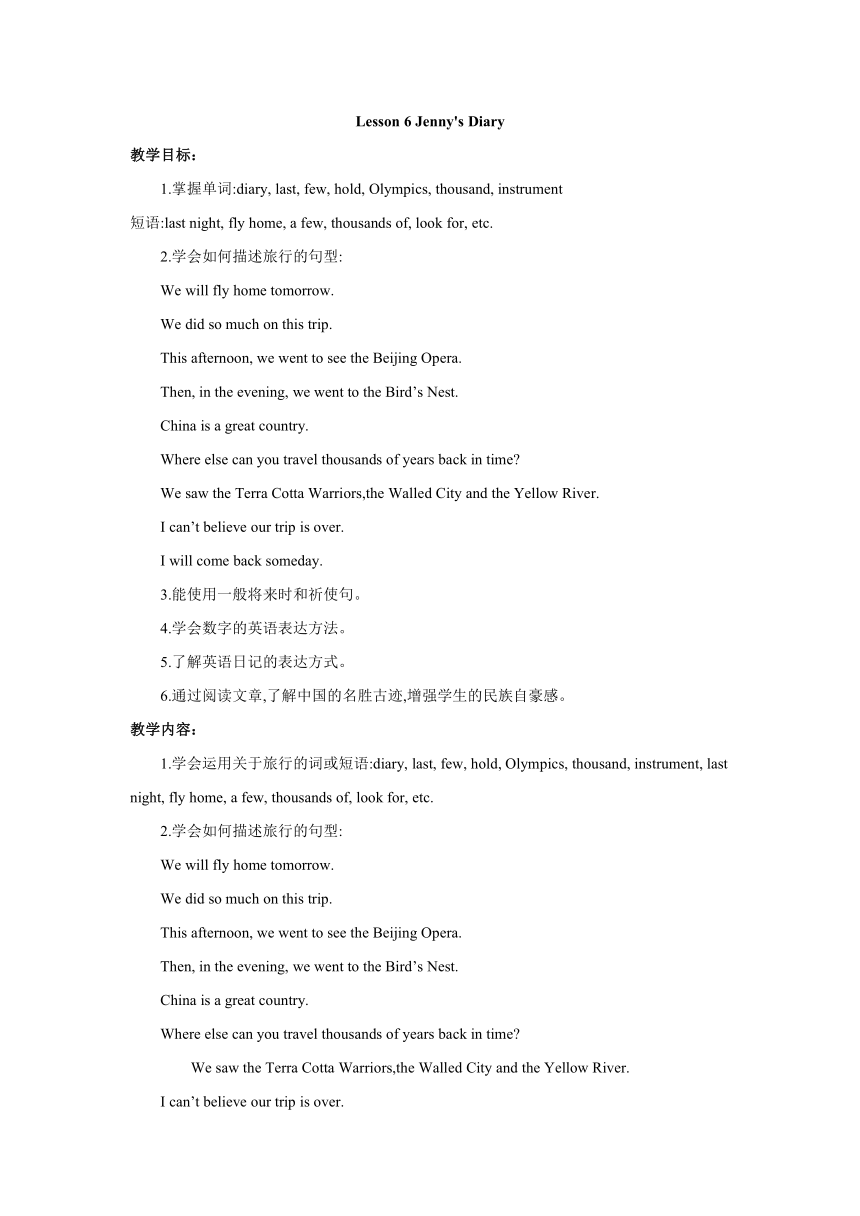 | |
| 格式 | zip | ||
| 文件大小 | 36.4KB | ||
| 资源类型 | 教案 | ||
| 版本资源 | 冀教版 | ||
| 科目 | 英语 | ||
| 更新时间 | 2019-06-26 22:10:23 | ||
图片预览

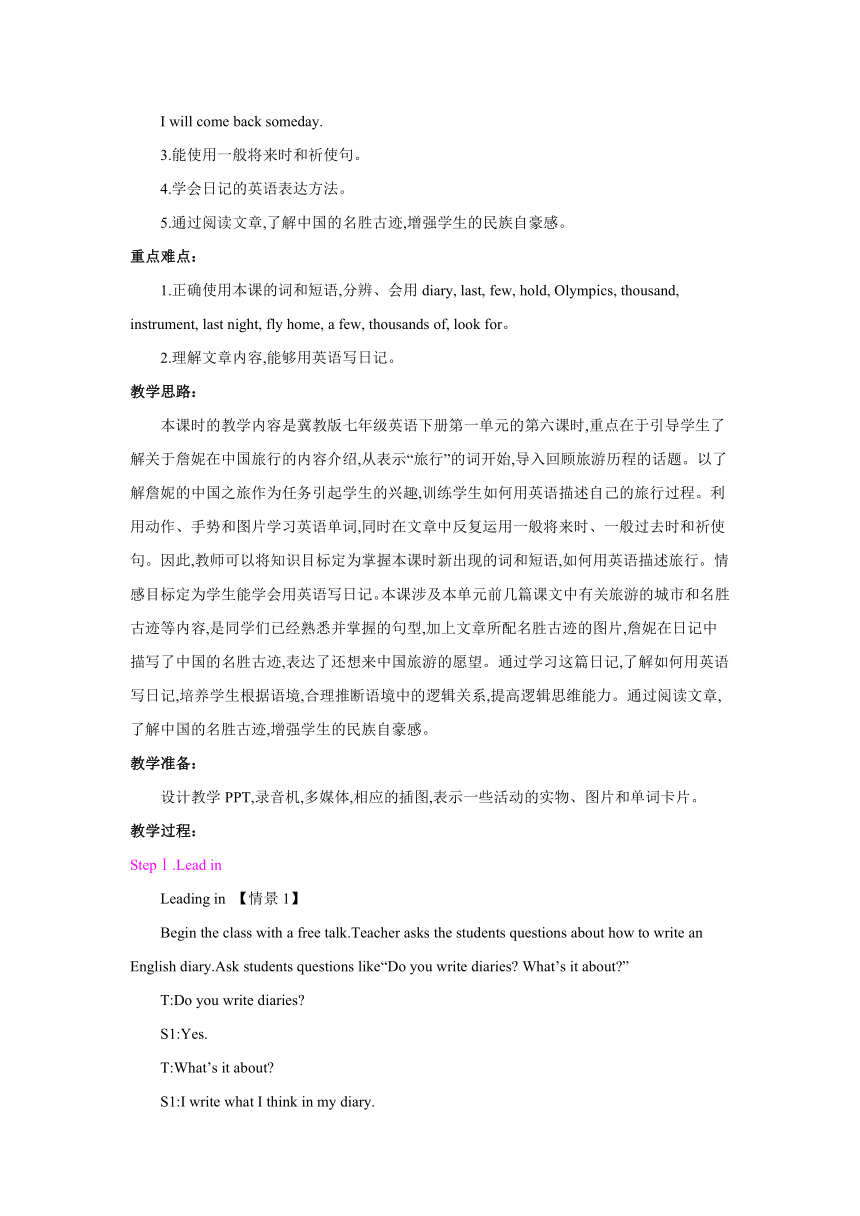
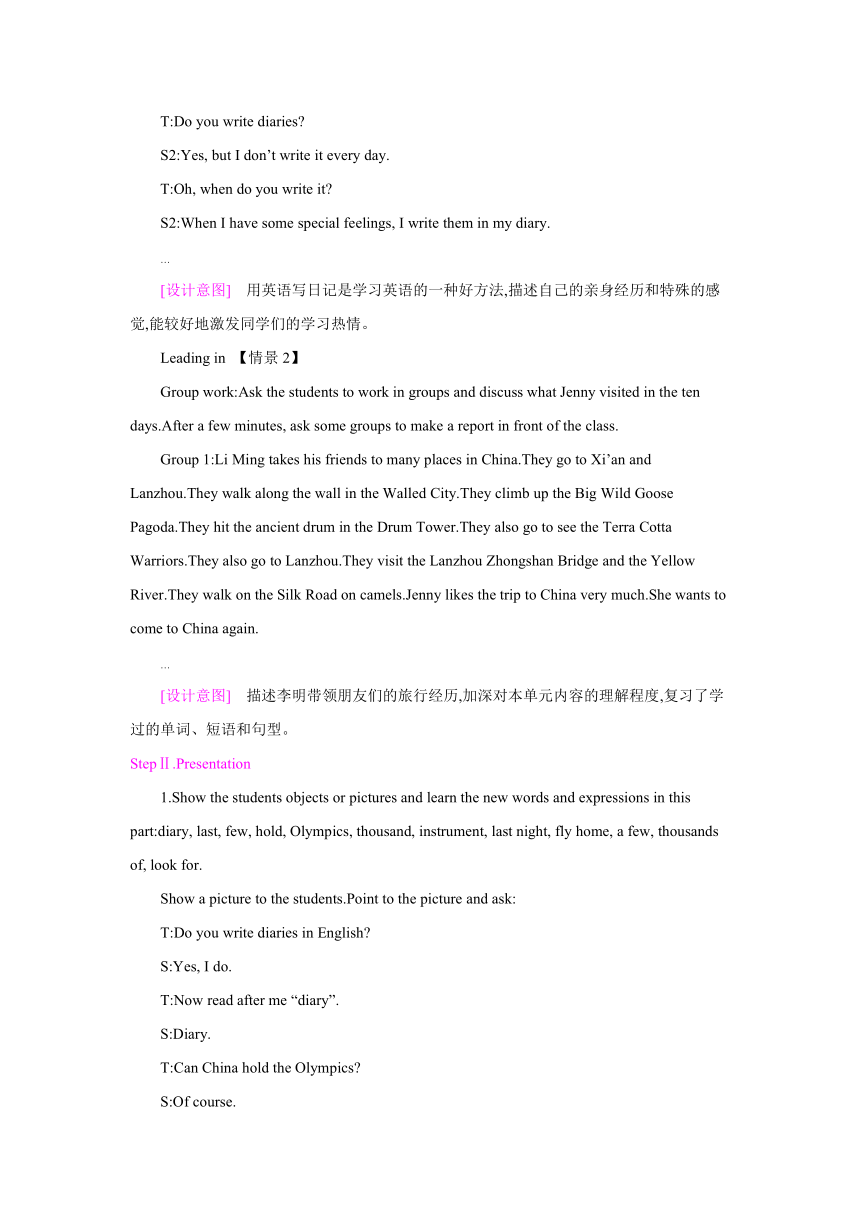
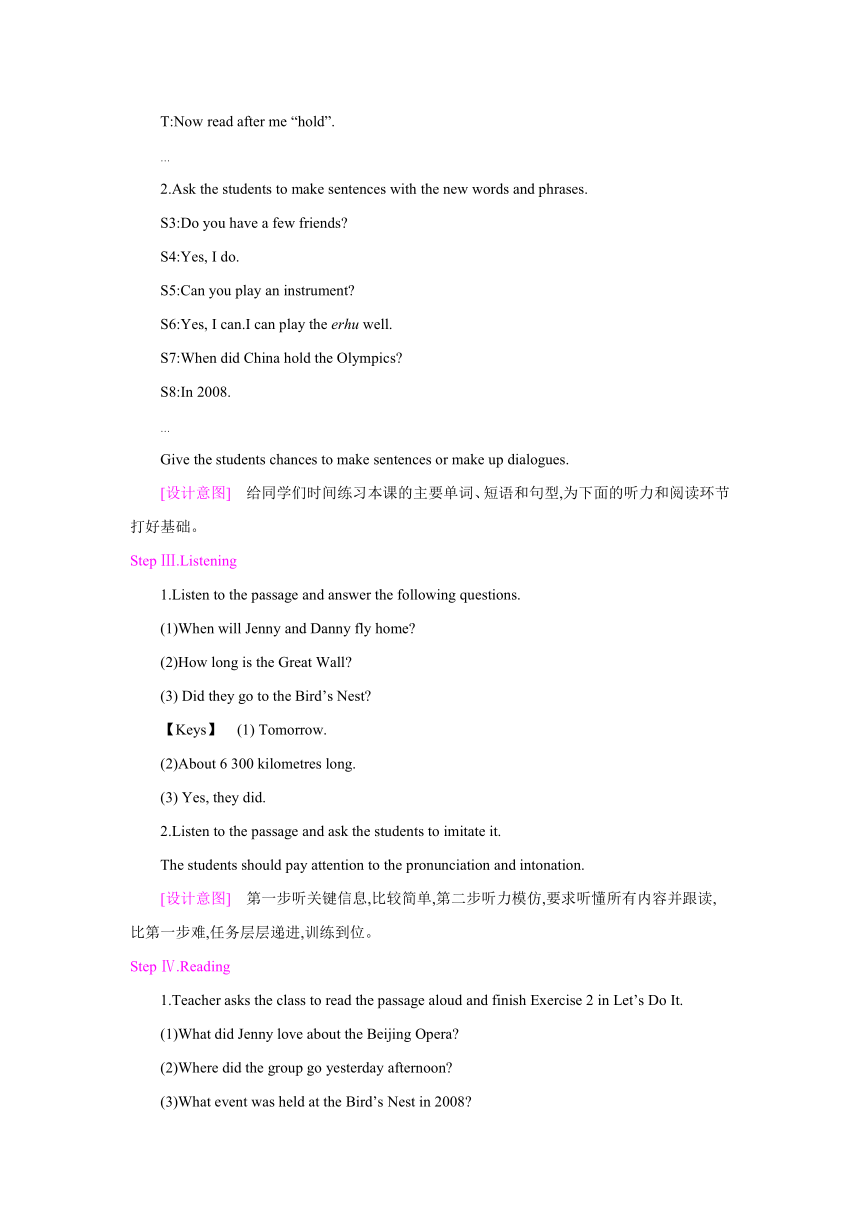
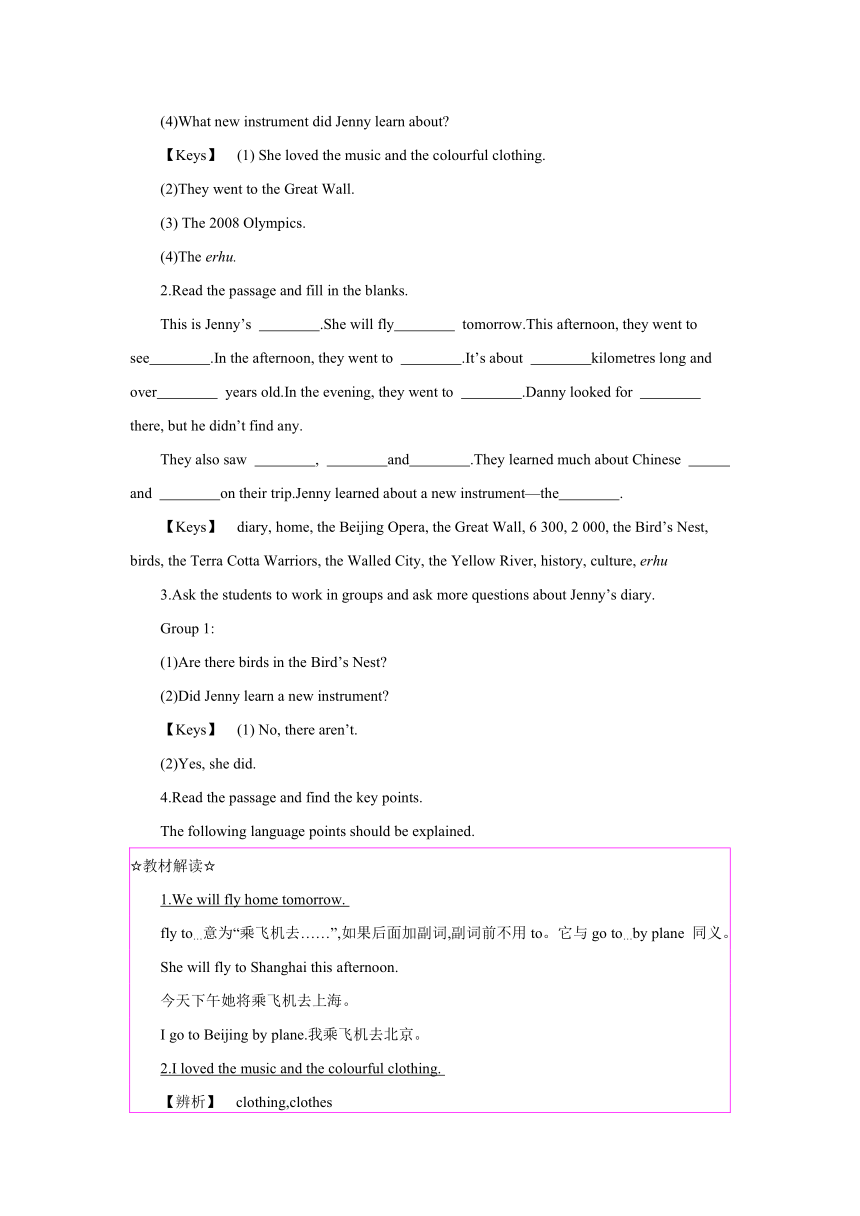
文档简介
Lesson 6 Jenny's Diary
教学目标:
1.掌握单词:diary, last, few, hold, Olympics, thousand, instrument
短语:last night, fly home, a few, thousands of, look for, etc.
2.学会如何描述旅行的句型:
We will fly home tomorrow.
We did so much on this trip.
This afternoon, we went to see the Beijing Opera.
Then, in the evening, we went to the Bird’s Nest.
China is a great country.
Where else can you travel thousands of years back in time?
We saw the Terra Cotta Warriors,the Walled City and the Yellow River.
I can’t believe our trip is over.
I will come back someday.
3.能使用一般将来时和祈使句。
4.学会数字的英语表达方法。
5.了解英语日记的表达方式。
6.通过阅读文章,了解中国的名胜古迹,增强学生的民族自豪感。
教学内容:
1.学会运用关于旅行的词或短语:diary, last, few, hold, Olympics, thousand, instrument, last night, fly home, a few, thousands of, look for, etc.
2.学会如何描述旅行的句型:
We will fly home tomorrow.
We did so much on this trip.
This afternoon, we went to see the Beijing Opera.
Then, in the evening, we went to the Bird’s Nest.
China is a great country.
Where else can you travel thousands of years back in time?
We saw the Terra Cotta Warriors,the Walled City and the Yellow River.
I can’t believe our trip is over.
I will come back someday.
3.能使用一般将来时和祈使句。
4.学会日记的英语表达方法。
5.通过阅读文章,了解中国的名胜古迹,增强学生的民族自豪感。
重点难点:
1.正确使用本课的词和短语,分辨、会用diary, last, few, hold, Olympics, thousand, instrument, last night, fly home, a few, thousands of, look for。
2.理解文章内容,能够用英语写日记。
教学思路:
本课时的教学内容是冀教版七年级英语下册第一单元的第六课时,重点在于引导学生了解关于詹妮在中国旅行的内容介绍,从表示“旅行”的词开始,导入回顾旅游历程的话题。以了解詹妮的中国之旅作为任务引起学生的兴趣,训练学生如何用英语描述自己的旅行过程。利用动作、手势和图片学习英语单词,同时在文章中反复运用一般将来时、一般过去时和祈使句。因此,教师可以将知识目标定为掌握本课时新出现的词和短语,如何用英语描述旅行。情感目标定为学生能学会用英语写日记。本课涉及本单元前几篇课文中有关旅游的城市和名胜古迹等内容,是同学们已经熟悉并掌握的句型,加上文章所配名胜古迹的图片,詹妮在日记中描写了中国的名胜古迹,表达了还想来中国旅游的愿望。通过学习这篇日记,了解如何用英语写日记,培养学生根据语境,合理推断语境中的逻辑关系,提高逻辑思维能力。通过阅读文章,了解中国的名胜古迹,增强学生的民族自豪感。
教学准备:
设计教学PPT,录音机,多媒体,相应的插图,表示一些活动的实物、图片和单词卡片。
教学过程:
StepⅠ.Lead in
Leading in 【情景1】
Begin the class with a free talk.Teacher asks the students questions about how to write an English diary.Ask students questions like“Do you write diaries? What’s it about?”
T:Do you write diaries?
S1:Yes.
T:What’s it about?
S1:I write what I think in my diary.
T:Do you write diaries?
S2:Yes, but I don’t write it every day.
T:Oh, when do you write it?
S2:When I have some special feelings, I write them in my diary.
…
[设计意图] 用英语写日记是学习英语的一种好方法,描述自己的亲身经历和特殊的感觉,能较好地激发同学们的学习热情。
Leading in 【情景2】
Group work:Ask the students to work in groups and discuss what Jenny visited in the ten days.After a few minutes, ask some groups to make a report in front of the class.
Group 1:Li Ming takes his friends to many places in China.They go to Xi’an and Lanzhou.They walk along the wall in the Walled City.They climb up the Big Wild Goose Pagoda.They hit the ancient drum in the Drum Tower.They also go to see the Terra Cotta Warriors.They also go to Lanzhou.They visit the Lanzhou Zhongshan Bridge and the Yellow River.They walk on the Silk Road on camels.Jenny likes the trip to China very much.She wants to come to China again.
…
[设计意图] 描述李明带领朋友们的旅行经历,加深对本单元内容的理解程度,复习了学过的单词、短语和句型。
StepⅡ.Presentation
1.Show the students objects or pictures and learn the new words and expressions in this part:diary, last, few, hold, Olympics, thousand, instrument, last night, fly home, a few, thousands of, look for.
Show a picture to the students.Point to the picture and ask:
T:Do you write diaries in English?
S:Yes, I do.
T:Now read after me “diary”.
S:Diary.
T:Can China hold the Olympics?
S:Of course.
T:Now read after me “hold”.
…
2.Ask the students to make sentences with the new words and phrases.
S3:Do you have a few friends?
S4:Yes, I do.
S5:Can you play an instrument?
S6:Yes, I can.I can play the erhu well.
S7:When did China hold the Olympics?
S8:In 2008.
…
Give the students chances to make sentences or make up dialogues.
[设计意图] 给同学们时间练习本课的主要单词、短语和句型,为下面的听力和阅读环节打好基础。
Step Ⅲ.Listening
1.Listen to the passage and answer the following questions.
(1)When will Jenny and Danny fly home?
(2)How long is the Great Wall?
(3) Did they go to the Bird’s Nest?
【Keys】 (1) Tomorrow.
(2)About 6 300 kilometres long.
(3) Yes, they did.
2.Listen to the passage and ask the students to imitate it.
The students should pay attention to the pronunciation and intonation.
[设计意图] 第一步听关键信息,比较简单,第二步听力模仿,要求听懂所有内容并跟读,比第一步难,任务层层递进,训练到位。
Step Ⅳ.Reading
1.Teacher asks the class to read the passage aloud and finish Exercise 2 in Let’s Do It.
(1)What did Jenny love about the Beijing Opera?
(2)Where did the group go yesterday afternoon?
(3)What event was held at the Bird’s Nest in 2008?
(4)What new instrument did Jenny learn about?
【Keys】 (1) She loved the music and the colourful clothing.
(2)They went to the Great Wall.
(3) The 2008 Olympics.
(4)The erhu.
2.Read the passage and fill in the blanks.
This is Jenny’s .She will fly tomorrow.This afternoon, they went to see .In the afternoon, they went to .It’s about kilometres long and over years old.In the evening, they went to .Danny looked for there, but he didn’t find any. ?
They also saw , and .They learned much about Chinese and on their trip.Jenny learned about a new instrument—the .?
【Keys】 diary, home, the Beijing Opera, the Great Wall, 6 300, 2 000, the Bird’s Nest, birds, the Terra Cotta Warriors, the Walled City, the Yellow River, history, culture, erhu
3.Ask the students to work in groups and ask more questions about Jenny’s diary.
Group 1:
(1)Are there birds in the Bird’s Nest?
(2)Did Jenny learn a new instrument?
【Keys】 (1) No, there aren’t.
(2)Yes, she did.
4.Read the passage and find the key points.
The following language points should be explained.
☆教材解读☆
1.We will fly home tomorrow.?
fly to…意为“乘飞机去……”,如果后面加副词,副词前不用to。它与go to…by plane 同义。
She will fly to Shanghai this afternoon.
今天下午她将乘飞机去上海。
I go to Beijing by plane.我乘飞机去北京。
2.I loved the music and the colourful clothing.?
【辨析】 clothing,clothes
(1)clothing 为不可数名词,强调“抽象概念的服装”。a clothing store意为“服装店”。
My sister opens a clothing store.
我姐姐开了一家服装店。
(2)clothes 为名词复数,强调“具体可见,摸到”的衣服。
My dad doesn’t like to wash clothes.
我爸爸不喜欢洗衣服。
3.It is only a few years old,...?
【辨析】 a few, few, a little, little
(1)a few一些,相当于some,修饰可数名词的复数,表示肯定。
I can see a few teachers in the dining hall.
在餐厅里我能看见一些老师。
(2)few没几个,修饰可数名词的复数,表示否定。
He has few friends.他没几个朋友。
(3)a little一些,相当于some,修饰不可数名词,表示肯定。
There is a little water in the bottle.
这个瓶子里有一点水。
(4)little没多少,修饰不可数名词,表示否定。
Sorry,I have little money.
对不起,我没有多少钱。
4.Where else can you travel thousands of years back in time??
◆else其他的,只能作后置定语,修饰不定代词或副词。when else其他什么时间;who else别的什么人;something else其他的东西。
【拓展】 other其他的,修饰名词,放在名词前,有时可与else转换。something else=other things。
◆hundred, thousand等表示单位的数词,如果前面有具体数字,不加s和of。如果表示概数,没有具体数字,则要加s和of。
The house can hold two thousand people.
这个房子可容纳2 000人。(前面有具体数字)
There are hundreds of trees in the park.这个公园里有数百棵树。(前面没有具体数字)
【拓展】 类似短语还有:hundreds of 数百的;millions of数百万的。这些都是不固定数量,表示固定数量时要用单数形式。
Their school has seven hundred students.
他们学校有七百名学生。
5.I can’t believe our trip is over.?
be over意为“完成;结束”。
When will the class be over? 什么时候下课?
6.I will come back someday.?
someday意为“某一天;有朝一日”,常用于一般将来时。
I will visit the moon someday.
有一天我会参观月球。
[设计意图] 读文章,找出问题的答案或补充文章,设计这样的阅读题有助于学生理解文章细节。
Step Ⅴ.Practice Writing
Group work:
1.Ask the students to retell the diary.
2.Ask the students to write a diary about one of their favourite trips.Every group chooses the best to read in front of the class.
When the students are writing, the teacher should walk around and give them advice.
[设计意图] 让学生们复述课文,然后写关于“你最喜欢的一次旅行”的短文,描述其中最精彩的环节,这是写作练习,是今天的主题的升华。
Step Ⅵ.Complete Let’s Do It!
Exercise 1 is used to practice the students’ listening.Listen to the tape and finish Exercise 1.Teacher can check the answers in class.We have finished Exercise 2 in reading part of the class.Ask the students to finish Exercise 3 by themselves in class.Teacher checks their answers in class.
[设计意图] Let’s Do It!部分中的Exercise 1重点是听说教学,考查同学们对课文的关键信息是否听清。Exercise 2重点是阅读教学,在课上作为阅读任务让同学们做。Exercise 3考查同学们对课文的掌握程度。
Step Ⅶ.Task
Pair work:Let’s Do It! Exercise 4.
Work in groups.Suggest some places Jenny can see on her next visit to China.
Group 1:Jenny can see some places of interest in the south of China.The weather is warmer than that in the north.There are more rivers and trees there.We can eat different kinds of fruit there.
[设计意图] 小组合作,谈论詹妮下次来中国可以游览的地方,介绍这些地方的优点。主要目的是练习本单元的主要语法内容:一般将来时和数字表达法,同时练习本课的主要单词、短语和句型。
Step Ⅷ.Exercises
Fill in the blanks.
1.别担心!我们下周会乘飞机回家。
Don’t worry! We will next week.?
2.我喜欢京剧中的多彩的衣服。
I like the in the Beijing Opera.?
3.其他的我们还能做什么?
can we do??
4.几千年之前,森林里有更多的动物。
years ago, there were more animals in the forest.?
5.在这次旅行中,你学到了什么?
What do you learn ??
【Keys】 1.fly home 2.colourful clothing 3.What else 4.Thousands of 5.on this trip
[设计意图] 以学评教、强化落实。当堂检测主要是由本节内容组成的形成性评价,让学生们巩固本课所学内容。
Step Ⅸ.Homework
1.Learn the new words and expressions by heart.
2.Read the diary after class.
3.Go over what you’ve learnt in this unit.
[设计意图] 听、说、读、写相结合,全方位训练学生各方面的英语能力。
Lesson 6 Jenny’s Diary
diary, last, few, hold, Olympics,
thousand,instrument, last night,
fly home, a few, thousands of, look for
We will fly home tomorrow.
We did so much on this trip.
China is a great country.
I can’t believe our trip is over.
I will come back someday.
This afternoon, we went to see the Beijing Opera.
Then, in the evening, we went to the Bird’s Nest.
Where else can you travel thousands of years back in time?
We saw the Terra Cotta Warriors,the Walled City and the Yellow River.
【Keys】
1 第1幅图, 第4幅图, 第5幅图
语法精讲
一、数词
(一) 定义与分类
数词是指表示数目多少或顺序先后的词。表示数目多少的数词叫基数词,如 one, five, ten, thirty, sixty-five 等;表示顺序先后的数词叫序数词,如 first, sixth, tenth, twenty-first 等。数词用法相当于名词和形容词,在句中可用作主语、宾语、表语、定语、同位语等。
(二)基数词
1.英语中没有“万”这个读数单位,要表示汉语中的“万”,英语需借用thousand一词,如“一万”用“十个千”表示(ten thousand),“十万”用“一百个千”表示(one hundred thousand)。
2.用作基数词单位的 hundred, thousand, million, billion 通常不带复数词尾-s,但若用于表示数百、数千、数百万这样的泛指,则用复数。
About two thousand people died in the earthquake.大约有两千人在地震中丧生。
Thousands of people go to the seaside every year.每年成千上万的人到海滨去。
3.表示整十的基数词用复数形式可以表示人的大约岁数或年代。
He is in his early twenties.他才二十出头。
This took place in the 1930s.
这事发生在20世纪30年代。
(三)序数词
1.许多序数词是由相应的基数词后加词尾-th构成的,如four/fourth,six/sixth,ten/tenth,sixteen/sixteenth,但是nine变为序数词是ninth,而不是nineth。
2.twentieth, thirtieth, fortieth等表示整十的序数词,由相应的基数词将词尾y改为ie,再加-th 构成。
3.first, second, third通常可缩写为1st, 2nd, 3rd。凡是以th结尾的序数词可缩写为“基数词+th”:4th, 5th, 9th, 11th, 60th, 128th等。
4.非整十的多位数,将个位数变成序数词即可:twenty-first(第21),thirty-sixth(第36),ninety-ninth(第99),three hundred and sixty-fifth(第365)等。
5.hundred, thousand, million等序数词形式为 hundredth, thousandth, millionth 等。
6.序数词前通常要用定冠词,但表示考试或比赛等的名次时,通常可省略其前的定冠词。
He was (the) third in the exam.
他考试得了第三名。
【注意】 (1)有时序数词前不用定冠词,而用不定冠词,表示次第在原有基础上的增加。
We’ll have to do it a second time.
我们得再做一次。
(2)序数词前用定冠词和不定冠词的区别在于:定冠词表特指,不定冠词表泛指,有类似another的意思,但比another 的意思更明确。
二、一般将来时(一)
(一)概念
一般将来时表示将来某一时刻的动作或状态,或将来要发生的事情。
(二)构成
主语 +will+动词原形
(三)用法
一般将来时常与一些表示将来的时间状语连用,如:tomorrow(明天), next week(下周), from now on(从现在开始);in the future(将来);someday (未来的某一天) 等。
(四)一般将来时的句子结构
1.肯定句:
My father will go to Shanghai next week.
我父亲下周要去上海。
We shall go to school tomorrow.
明天我们将要去上学。
2.否定句:
My father won’t go to Shanghai next week.
我父亲下周将不会去上海。
We shall not go to school tomorrow.
我们明天将不去上学。
3.一般疑问句:
Will your father go to Shanghai next week?
你爸爸下周将要去上海吗?
肯定回答:Yes, he will.是的,他将要去。
否定回答:No, he won’t.不,他将不去。
Shall we go to school tomorrow?
我们明天将要去上学吗?
肯定回答:Yes, we shall.是的,我们将会。
否定回答:No, we shall not.不,我们将不会。
4.特殊疑问句:
—When will your father go to Shanghai?
你爸爸什么时候将要去上海?
—Next week.下周。
—When shall we go to school?
我们什么时候去上学?
—Tomorrow.明天。
【注意】 will 用于各种人称, shall 只用于第一人称I,we。
教学目标:
1.掌握单词:diary, last, few, hold, Olympics, thousand, instrument
短语:last night, fly home, a few, thousands of, look for, etc.
2.学会如何描述旅行的句型:
We will fly home tomorrow.
We did so much on this trip.
This afternoon, we went to see the Beijing Opera.
Then, in the evening, we went to the Bird’s Nest.
China is a great country.
Where else can you travel thousands of years back in time?
We saw the Terra Cotta Warriors,the Walled City and the Yellow River.
I can’t believe our trip is over.
I will come back someday.
3.能使用一般将来时和祈使句。
4.学会数字的英语表达方法。
5.了解英语日记的表达方式。
6.通过阅读文章,了解中国的名胜古迹,增强学生的民族自豪感。
教学内容:
1.学会运用关于旅行的词或短语:diary, last, few, hold, Olympics, thousand, instrument, last night, fly home, a few, thousands of, look for, etc.
2.学会如何描述旅行的句型:
We will fly home tomorrow.
We did so much on this trip.
This afternoon, we went to see the Beijing Opera.
Then, in the evening, we went to the Bird’s Nest.
China is a great country.
Where else can you travel thousands of years back in time?
We saw the Terra Cotta Warriors,the Walled City and the Yellow River.
I can’t believe our trip is over.
I will come back someday.
3.能使用一般将来时和祈使句。
4.学会日记的英语表达方法。
5.通过阅读文章,了解中国的名胜古迹,增强学生的民族自豪感。
重点难点:
1.正确使用本课的词和短语,分辨、会用diary, last, few, hold, Olympics, thousand, instrument, last night, fly home, a few, thousands of, look for。
2.理解文章内容,能够用英语写日记。
教学思路:
本课时的教学内容是冀教版七年级英语下册第一单元的第六课时,重点在于引导学生了解关于詹妮在中国旅行的内容介绍,从表示“旅行”的词开始,导入回顾旅游历程的话题。以了解詹妮的中国之旅作为任务引起学生的兴趣,训练学生如何用英语描述自己的旅行过程。利用动作、手势和图片学习英语单词,同时在文章中反复运用一般将来时、一般过去时和祈使句。因此,教师可以将知识目标定为掌握本课时新出现的词和短语,如何用英语描述旅行。情感目标定为学生能学会用英语写日记。本课涉及本单元前几篇课文中有关旅游的城市和名胜古迹等内容,是同学们已经熟悉并掌握的句型,加上文章所配名胜古迹的图片,詹妮在日记中描写了中国的名胜古迹,表达了还想来中国旅游的愿望。通过学习这篇日记,了解如何用英语写日记,培养学生根据语境,合理推断语境中的逻辑关系,提高逻辑思维能力。通过阅读文章,了解中国的名胜古迹,增强学生的民族自豪感。
教学准备:
设计教学PPT,录音机,多媒体,相应的插图,表示一些活动的实物、图片和单词卡片。
教学过程:
StepⅠ.Lead in
Leading in 【情景1】
Begin the class with a free talk.Teacher asks the students questions about how to write an English diary.Ask students questions like“Do you write diaries? What’s it about?”
T:Do you write diaries?
S1:Yes.
T:What’s it about?
S1:I write what I think in my diary.
T:Do you write diaries?
S2:Yes, but I don’t write it every day.
T:Oh, when do you write it?
S2:When I have some special feelings, I write them in my diary.
…
[设计意图] 用英语写日记是学习英语的一种好方法,描述自己的亲身经历和特殊的感觉,能较好地激发同学们的学习热情。
Leading in 【情景2】
Group work:Ask the students to work in groups and discuss what Jenny visited in the ten days.After a few minutes, ask some groups to make a report in front of the class.
Group 1:Li Ming takes his friends to many places in China.They go to Xi’an and Lanzhou.They walk along the wall in the Walled City.They climb up the Big Wild Goose Pagoda.They hit the ancient drum in the Drum Tower.They also go to see the Terra Cotta Warriors.They also go to Lanzhou.They visit the Lanzhou Zhongshan Bridge and the Yellow River.They walk on the Silk Road on camels.Jenny likes the trip to China very much.She wants to come to China again.
…
[设计意图] 描述李明带领朋友们的旅行经历,加深对本单元内容的理解程度,复习了学过的单词、短语和句型。
StepⅡ.Presentation
1.Show the students objects or pictures and learn the new words and expressions in this part:diary, last, few, hold, Olympics, thousand, instrument, last night, fly home, a few, thousands of, look for.
Show a picture to the students.Point to the picture and ask:
T:Do you write diaries in English?
S:Yes, I do.
T:Now read after me “diary”.
S:Diary.
T:Can China hold the Olympics?
S:Of course.
T:Now read after me “hold”.
…
2.Ask the students to make sentences with the new words and phrases.
S3:Do you have a few friends?
S4:Yes, I do.
S5:Can you play an instrument?
S6:Yes, I can.I can play the erhu well.
S7:When did China hold the Olympics?
S8:In 2008.
…
Give the students chances to make sentences or make up dialogues.
[设计意图] 给同学们时间练习本课的主要单词、短语和句型,为下面的听力和阅读环节打好基础。
Step Ⅲ.Listening
1.Listen to the passage and answer the following questions.
(1)When will Jenny and Danny fly home?
(2)How long is the Great Wall?
(3) Did they go to the Bird’s Nest?
【Keys】 (1) Tomorrow.
(2)About 6 300 kilometres long.
(3) Yes, they did.
2.Listen to the passage and ask the students to imitate it.
The students should pay attention to the pronunciation and intonation.
[设计意图] 第一步听关键信息,比较简单,第二步听力模仿,要求听懂所有内容并跟读,比第一步难,任务层层递进,训练到位。
Step Ⅳ.Reading
1.Teacher asks the class to read the passage aloud and finish Exercise 2 in Let’s Do It.
(1)What did Jenny love about the Beijing Opera?
(2)Where did the group go yesterday afternoon?
(3)What event was held at the Bird’s Nest in 2008?
(4)What new instrument did Jenny learn about?
【Keys】 (1) She loved the music and the colourful clothing.
(2)They went to the Great Wall.
(3) The 2008 Olympics.
(4)The erhu.
2.Read the passage and fill in the blanks.
This is Jenny’s .She will fly tomorrow.This afternoon, they went to see .In the afternoon, they went to .It’s about kilometres long and over years old.In the evening, they went to .Danny looked for there, but he didn’t find any. ?
They also saw , and .They learned much about Chinese and on their trip.Jenny learned about a new instrument—the .?
【Keys】 diary, home, the Beijing Opera, the Great Wall, 6 300, 2 000, the Bird’s Nest, birds, the Terra Cotta Warriors, the Walled City, the Yellow River, history, culture, erhu
3.Ask the students to work in groups and ask more questions about Jenny’s diary.
Group 1:
(1)Are there birds in the Bird’s Nest?
(2)Did Jenny learn a new instrument?
【Keys】 (1) No, there aren’t.
(2)Yes, she did.
4.Read the passage and find the key points.
The following language points should be explained.
☆教材解读☆
1.We will fly home tomorrow.?
fly to…意为“乘飞机去……”,如果后面加副词,副词前不用to。它与go to…by plane 同义。
She will fly to Shanghai this afternoon.
今天下午她将乘飞机去上海。
I go to Beijing by plane.我乘飞机去北京。
2.I loved the music and the colourful clothing.?
【辨析】 clothing,clothes
(1)clothing 为不可数名词,强调“抽象概念的服装”。a clothing store意为“服装店”。
My sister opens a clothing store.
我姐姐开了一家服装店。
(2)clothes 为名词复数,强调“具体可见,摸到”的衣服。
My dad doesn’t like to wash clothes.
我爸爸不喜欢洗衣服。
3.It is only a few years old,...?
【辨析】 a few, few, a little, little
(1)a few一些,相当于some,修饰可数名词的复数,表示肯定。
I can see a few teachers in the dining hall.
在餐厅里我能看见一些老师。
(2)few没几个,修饰可数名词的复数,表示否定。
He has few friends.他没几个朋友。
(3)a little一些,相当于some,修饰不可数名词,表示肯定。
There is a little water in the bottle.
这个瓶子里有一点水。
(4)little没多少,修饰不可数名词,表示否定。
Sorry,I have little money.
对不起,我没有多少钱。
4.Where else can you travel thousands of years back in time??
◆else其他的,只能作后置定语,修饰不定代词或副词。when else其他什么时间;who else别的什么人;something else其他的东西。
【拓展】 other其他的,修饰名词,放在名词前,有时可与else转换。something else=other things。
◆hundred, thousand等表示单位的数词,如果前面有具体数字,不加s和of。如果表示概数,没有具体数字,则要加s和of。
The house can hold two thousand people.
这个房子可容纳2 000人。(前面有具体数字)
There are hundreds of trees in the park.这个公园里有数百棵树。(前面没有具体数字)
【拓展】 类似短语还有:hundreds of 数百的;millions of数百万的。这些都是不固定数量,表示固定数量时要用单数形式。
Their school has seven hundred students.
他们学校有七百名学生。
5.I can’t believe our trip is over.?
be over意为“完成;结束”。
When will the class be over? 什么时候下课?
6.I will come back someday.?
someday意为“某一天;有朝一日”,常用于一般将来时。
I will visit the moon someday.
有一天我会参观月球。
[设计意图] 读文章,找出问题的答案或补充文章,设计这样的阅读题有助于学生理解文章细节。
Step Ⅴ.Practice Writing
Group work:
1.Ask the students to retell the diary.
2.Ask the students to write a diary about one of their favourite trips.Every group chooses the best to read in front of the class.
When the students are writing, the teacher should walk around and give them advice.
[设计意图] 让学生们复述课文,然后写关于“你最喜欢的一次旅行”的短文,描述其中最精彩的环节,这是写作练习,是今天的主题的升华。
Step Ⅵ.Complete Let’s Do It!
Exercise 1 is used to practice the students’ listening.Listen to the tape and finish Exercise 1.Teacher can check the answers in class.We have finished Exercise 2 in reading part of the class.Ask the students to finish Exercise 3 by themselves in class.Teacher checks their answers in class.
[设计意图] Let’s Do It!部分中的Exercise 1重点是听说教学,考查同学们对课文的关键信息是否听清。Exercise 2重点是阅读教学,在课上作为阅读任务让同学们做。Exercise 3考查同学们对课文的掌握程度。
Step Ⅶ.Task
Pair work:Let’s Do It! Exercise 4.
Work in groups.Suggest some places Jenny can see on her next visit to China.
Group 1:Jenny can see some places of interest in the south of China.The weather is warmer than that in the north.There are more rivers and trees there.We can eat different kinds of fruit there.
[设计意图] 小组合作,谈论詹妮下次来中国可以游览的地方,介绍这些地方的优点。主要目的是练习本单元的主要语法内容:一般将来时和数字表达法,同时练习本课的主要单词、短语和句型。
Step Ⅷ.Exercises
Fill in the blanks.
1.别担心!我们下周会乘飞机回家。
Don’t worry! We will next week.?
2.我喜欢京剧中的多彩的衣服。
I like the in the Beijing Opera.?
3.其他的我们还能做什么?
can we do??
4.几千年之前,森林里有更多的动物。
years ago, there were more animals in the forest.?
5.在这次旅行中,你学到了什么?
What do you learn ??
【Keys】 1.fly home 2.colourful clothing 3.What else 4.Thousands of 5.on this trip
[设计意图] 以学评教、强化落实。当堂检测主要是由本节内容组成的形成性评价,让学生们巩固本课所学内容。
Step Ⅸ.Homework
1.Learn the new words and expressions by heart.
2.Read the diary after class.
3.Go over what you’ve learnt in this unit.
[设计意图] 听、说、读、写相结合,全方位训练学生各方面的英语能力。
Lesson 6 Jenny’s Diary
diary, last, few, hold, Olympics,
thousand,instrument, last night,
fly home, a few, thousands of, look for
We will fly home tomorrow.
We did so much on this trip.
China is a great country.
I can’t believe our trip is over.
I will come back someday.
This afternoon, we went to see the Beijing Opera.
Then, in the evening, we went to the Bird’s Nest.
Where else can you travel thousands of years back in time?
We saw the Terra Cotta Warriors,the Walled City and the Yellow River.
【Keys】
1 第1幅图, 第4幅图, 第5幅图
语法精讲
一、数词
(一) 定义与分类
数词是指表示数目多少或顺序先后的词。表示数目多少的数词叫基数词,如 one, five, ten, thirty, sixty-five 等;表示顺序先后的数词叫序数词,如 first, sixth, tenth, twenty-first 等。数词用法相当于名词和形容词,在句中可用作主语、宾语、表语、定语、同位语等。
(二)基数词
1.英语中没有“万”这个读数单位,要表示汉语中的“万”,英语需借用thousand一词,如“一万”用“十个千”表示(ten thousand),“十万”用“一百个千”表示(one hundred thousand)。
2.用作基数词单位的 hundred, thousand, million, billion 通常不带复数词尾-s,但若用于表示数百、数千、数百万这样的泛指,则用复数。
About two thousand people died in the earthquake.大约有两千人在地震中丧生。
Thousands of people go to the seaside every year.每年成千上万的人到海滨去。
3.表示整十的基数词用复数形式可以表示人的大约岁数或年代。
He is in his early twenties.他才二十出头。
This took place in the 1930s.
这事发生在20世纪30年代。
(三)序数词
1.许多序数词是由相应的基数词后加词尾-th构成的,如four/fourth,six/sixth,ten/tenth,sixteen/sixteenth,但是nine变为序数词是ninth,而不是nineth。
2.twentieth, thirtieth, fortieth等表示整十的序数词,由相应的基数词将词尾y改为ie,再加-th 构成。
3.first, second, third通常可缩写为1st, 2nd, 3rd。凡是以th结尾的序数词可缩写为“基数词+th”:4th, 5th, 9th, 11th, 60th, 128th等。
4.非整十的多位数,将个位数变成序数词即可:twenty-first(第21),thirty-sixth(第36),ninety-ninth(第99),three hundred and sixty-fifth(第365)等。
5.hundred, thousand, million等序数词形式为 hundredth, thousandth, millionth 等。
6.序数词前通常要用定冠词,但表示考试或比赛等的名次时,通常可省略其前的定冠词。
He was (the) third in the exam.
他考试得了第三名。
【注意】 (1)有时序数词前不用定冠词,而用不定冠词,表示次第在原有基础上的增加。
We’ll have to do it a second time.
我们得再做一次。
(2)序数词前用定冠词和不定冠词的区别在于:定冠词表特指,不定冠词表泛指,有类似another的意思,但比another 的意思更明确。
二、一般将来时(一)
(一)概念
一般将来时表示将来某一时刻的动作或状态,或将来要发生的事情。
(二)构成
主语 +will+动词原形
(三)用法
一般将来时常与一些表示将来的时间状语连用,如:tomorrow(明天), next week(下周), from now on(从现在开始);in the future(将来);someday (未来的某一天) 等。
(四)一般将来时的句子结构
1.肯定句:
My father will go to Shanghai next week.
我父亲下周要去上海。
We shall go to school tomorrow.
明天我们将要去上学。
2.否定句:
My father won’t go to Shanghai next week.
我父亲下周将不会去上海。
We shall not go to school tomorrow.
我们明天将不去上学。
3.一般疑问句:
Will your father go to Shanghai next week?
你爸爸下周将要去上海吗?
肯定回答:Yes, he will.是的,他将要去。
否定回答:No, he won’t.不,他将不去。
Shall we go to school tomorrow?
我们明天将要去上学吗?
肯定回答:Yes, we shall.是的,我们将会。
否定回答:No, we shall not.不,我们将不会。
4.特殊疑问句:
—When will your father go to Shanghai?
你爸爸什么时候将要去上海?
—Next week.下周。
—When shall we go to school?
我们什么时候去上学?
—Tomorrow.明天。
【注意】 will 用于各种人称, shall 只用于第一人称I,we。
同课章节目录
- Unit 1 A Trip to the Silk Road
- Lesson 1 A Trip to China
- Lesson 2 Meet You in Beijing
- Lesson 3 A Visit to Xi'an
- Lesson 4 A Visit to Lanzhou
- Lesson 5 Another Stop along the Silk Road
- Lesson 6 Jenny's Diary
- Unit 2 It's Show Time!
- Lesson 7 What's Your Project about?
- Lesson 8 Marco Polo and the Silk Road
- Lesson 9 Danny's School Project
- Lesson 10 Music and Dance
- Lesson 11 Food in China
- Lesson 12 A Blog about the Silk Road
- Unit 3 School Life
- Lesson 13 How Is School Going?
- Lesson 14 Jenny's School Life
- Lesson 15 Making a Difference
- Lesson 16 We Are with You!
- Lesson 17 School Science Fai
- Lesson 18 Teaching in China
- Unit 4 After-School Activities
- Lesson 19 A Dinner Date
- Lesson 20 Join Our Club!
- Lesson 21 What Is Your Club Type?
- Lesson 22 Big Plans for the Weekend
- Lesson 23 A Weekend with Grandma
- Lesson 24 How was Your Weekend?
- Unit 5 I Love Learning English!
- Lesson 25 A Phone Friend
- Lesson 26 Online Phone Calls
- Lesson 27 Amazing English
- Lesson 28 How Do I Learn English?
- Lesson 29 A Door to the World
- Lesson 30 Writing an E-mail in English
- Unit 6 Seasons
- Lesson 31 What Strange Weather!
- Lesson 32 I Can't Wait for Winter!
- Lesson 33 Kim's Favourite Season
- Lesson 34 Steven's Report
- Lesson 35 Surfing in Sydney
- Lesson 36 Spring in China
- Unit 7 Sports and Good Health
- Lesson 37 You Are What You Eat!
- Lesson 38 Stay Healthy!
- Lesson 39 Danny's Report
- Lesson 40 Move Your Body
- Lesson 41 Were People Healthy Then?
- Lesson 42 Know Yourself
- Unit 8 Summer Holiday Is Coming!
- Lesson 43 Have a Good Summer!
- Lesson 44 Volunteering in Summe
- Lesson 45 Baseball Season
- Lesson 46 Get Ready for Summer Holiday!
- Lesson 47 Summer Plans
- Lesson 48 Li Ming's Summer Holiday
